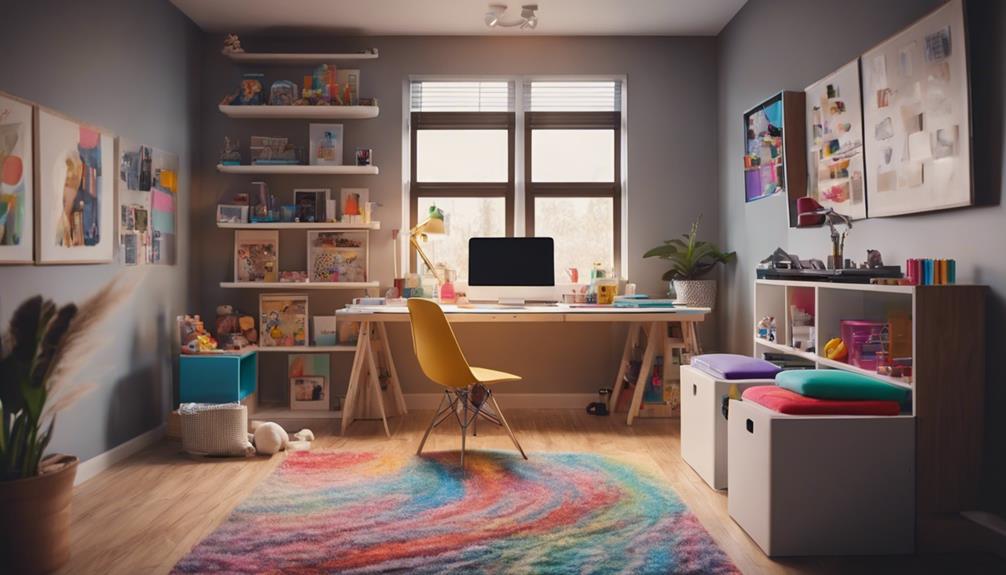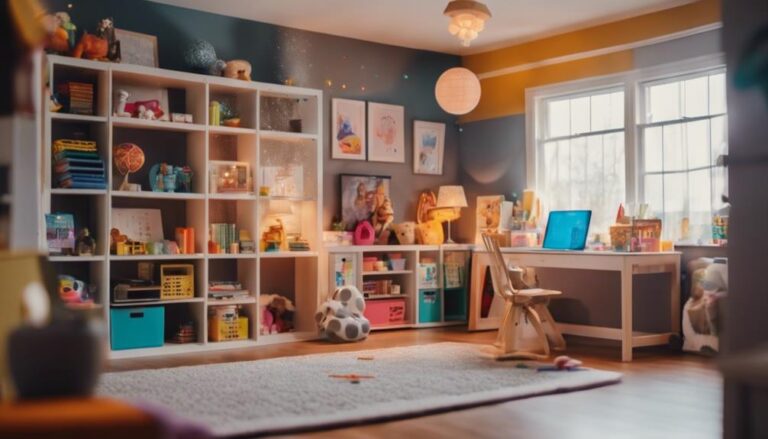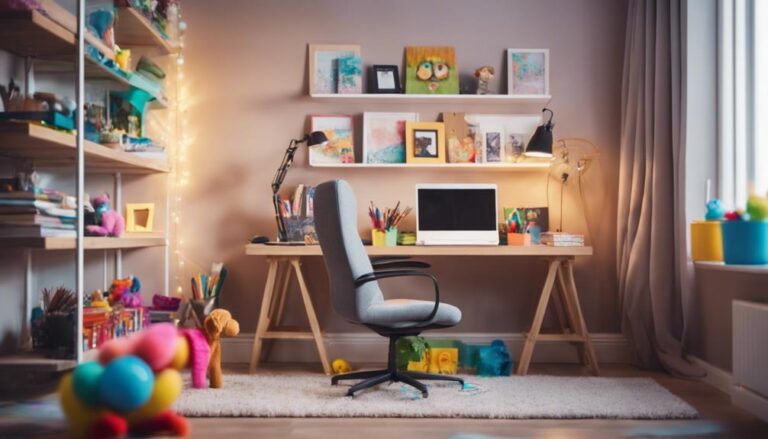I've found that successful child-friendly home offices blend clear boundaries, dedicated zones, and engaging activities to create a harmonious and productive environment. Establishing separate workspaces for adults and kids helps maintain focus. Adding stimulating child activity areas and cozy nooks promotes creativity and learning. Scheduling breaks with fun activities keeps everyone energized and reduces stress. Vital, ergonomic furniture, and access to educational resources are essential. Encouraging collaboration and sharing decision-making makes kids feel responsible and involved. By balancing these elements, we can guarantee a harmonious work environment that supports both productivity and family bonding. Curious how to bring this to life?
Key Takeaways
- Clear boundaries and dedicated workspaces enhance focus and productivity for both adults and children.
- Incorporating child-friendly activities and multi-functional furniture ensures a versatile and safe environment.
- Stimulating environments with visual appeal and cozy reading nooks foster creativity and academic performance.
- Scheduled breaks with short, fun activities boost energy, productivity, and reduce stress.
- Encouraging teamwork and involving children in age-appropriate tasks fosters responsibility and engagement.
Establishing Clear Boundaries
Establishing clear boundaries in a child-friendly home office is crucial for maintaining focus and productivity during work hours. By setting these boundaries, I guarantee my children understand when it's appropriate to interact with me. This clarity creates a harmonious balance between work and family life, allowing me to switch seamlessly between work and play.
Defined boundaries contribute to a structured routine, helping both my professional tasks and my children's activities flow smoothly. It's not just about keeping my workspace undisturbed; it's about enhancing communication and respect within our home.
Innovation in family-oriented work environments starts with clear boundaries, ensuring everyone knows when it's time to be serious and when it's time to relax and enjoy family moments.
Creating Dedicated Zones
Creating dedicated zones in a home office is essential for maintaining focus and minimizing distractions.
By setting up separate workspaces for myself and designated activity areas for the kids, we can enhance productivity and organization.
Shared family spaces can then become centers for collaborative activities, promoting a balanced and harmonious household.
Separate Workspaces
Designating separate workspaces within the home office can greatly enhance focus and productivity for both adults and children. By clearly defining workspaces and play areas, we create essential boundaries that help everyone stay on task.
Each family member having their own workstation promotes a sense of ownership and responsibility, making it easier to maintain discipline and organization. Personalized setups in these distinct zones cater to individual needs and preferences, ensuring that everyone has a conducive environment for their activities.
Additionally, separate workspaces minimize distractions and interruptions during work hours, which is vital for maintaining efficiency. This thoughtful arrangement not only supports our professional endeavors but also fosters a balanced, harmonious home life.
Kid Activity Areas
While separate workspaces for adults and children are important, incorporating dedicated kid activity areas within the home office guarantees a structured and engaging environment for little ones.
I've found that setting up a kid-friendly home office with defined zones for small play and learning activities can be incredibly important. By including age-appropriate toys, books, and activities, children stay engaged, allowing me to work peacefully.
These dedicated areas foster a sense of structure and organization, which is essential for maintaining balance. When kids have a stimulating and safe environment, it not only enhances their development but also contributes to a harmonious family life.
Creating these zones is a practical way to combine productivity with family-friendly innovation.
Shared Family Space
To maintain focus and productivity, I find it crucial to establish dedicated work and play zones within the home office. By designating separate areas for work and kids' activities, I create clear boundaries that benefit the entire family.
In a shared family space, I set up a designated workspace for myself and a play area for the kids. Using physical dividers or strategically placed furniture, I create distinct zones that help balance work needs with child-friendly elements.
This approach not only enhances my productivity but also guarantees my kids have a safe and engaging environment. Implementing these zones transforms our home office into a functional, harmonious space for everyone.
Incorporating Child-Friendly Activities

Creating a child-friendly home office means incorporating engaging activities like puzzles and educational toys to keep kids entertained and stimulated. Kids know when their environment is inviting and engaging, making it essential to include activities that cater to their interests. Building blocks, art stations, and reading materials create a conducive and creative atmosphere.
Here's a quick reference table for some activities:
| Activity | Benefits | Suitable Age Group |
|---|---|---|
| Building Blocks | Enhances motor skills | 3-7 years |
| Art Station | Boosts creativity | 4-10 years |
| Storybooks | Fosters imagination | 2-8 years |
Ensuring Safety and Ergonomics
When setting up a child-friendly home office, I prioritize securing cords and covering outlets to prevent accidents.
I also select ergonomic furniture with rounded corners, stable designs, and provide comfortable seating for both myself and my children.
This creates a safe and productive environment where we can all thrive.
Child-Proofing Work Area
Securing cords, covering outlets, and choosing furniture with rounded corners are essential steps to child-proofing your home office and ensuring a safe, ergonomic environment for both you and your children.
At home, I've found that covering electrical outlets with safety plugs and organizing cords with clips keeps curious fingers safe. Using furniture with rounded edges prevents injuries, promoting a secure space for everyone.
Safety gates can restrict access to hazardous areas, ensuring that your workspace remains productive and safe. Educating your children about safety protocols and setting clear boundaries are vital for maintaining an efficient environment.
Ergonomic Furniture Choices
Having secured the workspace for safety, it's important to choose ergonomic furniture that promotes comfort and proper posture for both adults and children. For adults, ergonomic chairs are essential for maintaining productivity and reducing strain during long work hours.
For children, investing in child-sized furniture such as tables and chairs can help them maintain good posture and support their development. Additionally, selecting furniture with rounded edges and stable designs minimizes the risk of accidents.
Bean bags and floor mats can create a comfortable and inviting space for kids, encouraging them to spend time in the home office. By focusing on ergonomic furniture and child-sized furniture, we create a balanced, safe, and efficient environment for the whole family.
Utilizing Multi-Functional Furniture

Ever wondered how multi-functional furniture can transform a cramped corner into an organized, child-friendly home office? By maximizing space efficiency, these versatile pieces serve multiple purposes: storage, seating, and workspace. A desk with built-in storage keeps the area clutter-free, while a convertible sofa bed or storage ottoman adds versatility.
Here's a quick overview:
| Furniture Type | Functionality | Benefits |
|---|---|---|
| Desk with storage | Workspace and storage | Keeps area organized |
| Convertible sofa bed | Seating and sleeping | Adds versatility |
| Storage ottoman | Seating and storage | Practical and space-saving |
Investing in multi-functional furniture meets the needs of both parents and children, making it easier to adapt the home office to various activities. This approach fosters a balanced environment for work, play, and learning.
Incorporating Educational Resources
While multi-functional furniture sets the stage for an organized and adaptable space, incorporating educational resources transforms it into a hub for learning and creativity. By adding books, learning materials, and interactive games, I can foster a love for learning in my child-friendly home office.
Educational posters and a chalkboard make the environment visually stimulating, while a cozy reading nook offers a dedicated space for quiet study. Access to technology and educational games introduces interactive elements that keep my child engaged. Personalizing the workspace with these educational tools not only enhances creativity but also boosts academic performance and curiosity.
A well-stocked, child-friendly home office becomes a powerful catalyst for my child's educational development.
Scheduling Breaks and Downtime

Scheduling regular breaks and downtime in our child-friendly home office is essential for maintaining productivity and preventing burnout. By integrating scheduled breaks into our structured workdays, both parents and children can enjoy a balanced work-life dynamic.
Short, fun activities during breaks can boost energy levels and focus. Here's how we make it work:
- Dancing or outdoor play: Quick bursts of fun keep everyone energized.
- Routine adjustment: Structured workdays with consistent breaks help children adapt to routines.
- Mental well-being: Regular breaks improve overall productivity and reduce stress.
Balancing work responsibilities with downtime activities not only promotes a harmonious environment but also enhances our overall well-being. This approach fosters a productive and stress-free home office for the entire family.
Encouraging a Collaborative Environment
Creating a collaborative environment in our child-friendly home office means actively involving our children in age-appropriate tasks and projects. By encouraging teamwork and shared decision-making, we foster a sense of responsibility and ownership in the workspace.
I've found that involving my children in small projects or activities not only promotes a cooperative work environment but also teaches them valuable lessons in teamwork and responsibility. Establishing opportunities for shared decision-making enhances their engagement and collaboration.
This approach helps create a harmonious workspace where everyone feels valued. It's amazing to see how these practices can transform a simple home office into a dynamic, collaborative environment that benefits the entire family.
Frequently Asked Questions
How Do I Make My Office Kid Friendly?
To make my office kid-friendly, I incorporate flexible furniture and interactive decor. I set clear boundaries, add playful elements, and create a designated study area. Childproofing and secure furniture guarantee a safe, organized, and engaging space.
What Makes a Child Friendly Environment?
A child-friendly environment thrives on interactive play and educational toys. I prioritize safety, personalization, and fun elements. By incorporating technology and sensory experiences, I create a space that supports development and fosters a love for learning.
How Do You Design Safe Spaces for Children?
Designing safe spaces for children is like building a fortress. I prioritize safety measures and childproofing essentials, securing furniture, keeping hazards out of reach, and creating cozy, personalized corners to guarantee a secure, welcoming environment.
Why Is Working With Children Better?
Working with children boosts my increased productivity and fosters stronger bonds within the team. Their fresh perspective and creativity inspire innovation and adaptability, making our work environment more dynamic and family-oriented, ultimately enhancing our development-focused goals.
Conclusion
In creating a child-friendly home office, it's important to set clear boundaries, create dedicated zones, and incorporate child-friendly activities.
Did you know that 70% of parents report increased productivity when their home office is well-organized and child-friendly?
By ensuring safety, utilizing multi-functional furniture, and incorporating educational resources, we can foster a collaborative, productive environment.
Don't forget to schedule breaks and downtime to keep everyone happy and balanced—family harmony truly boosts overall effectiveness.






